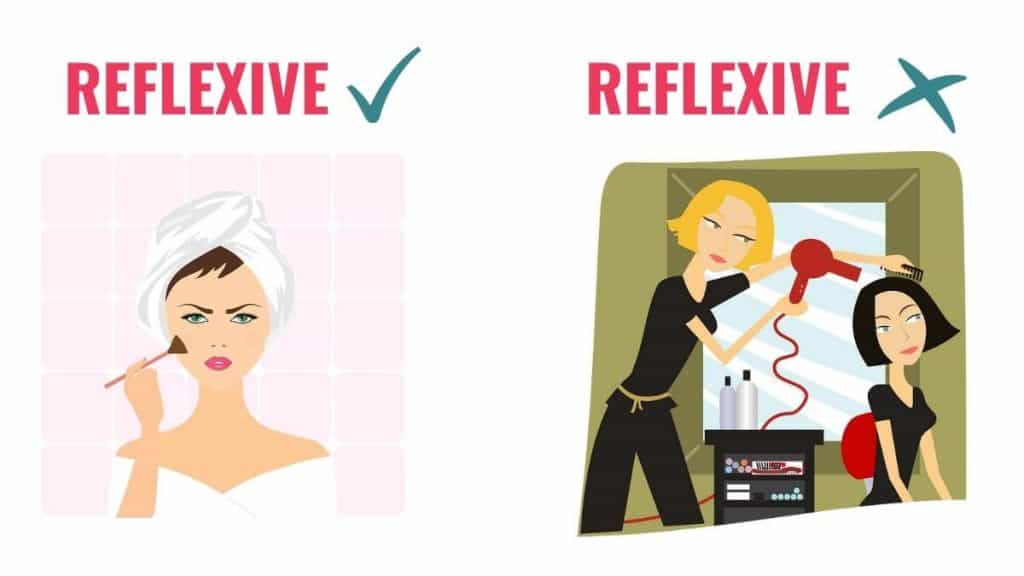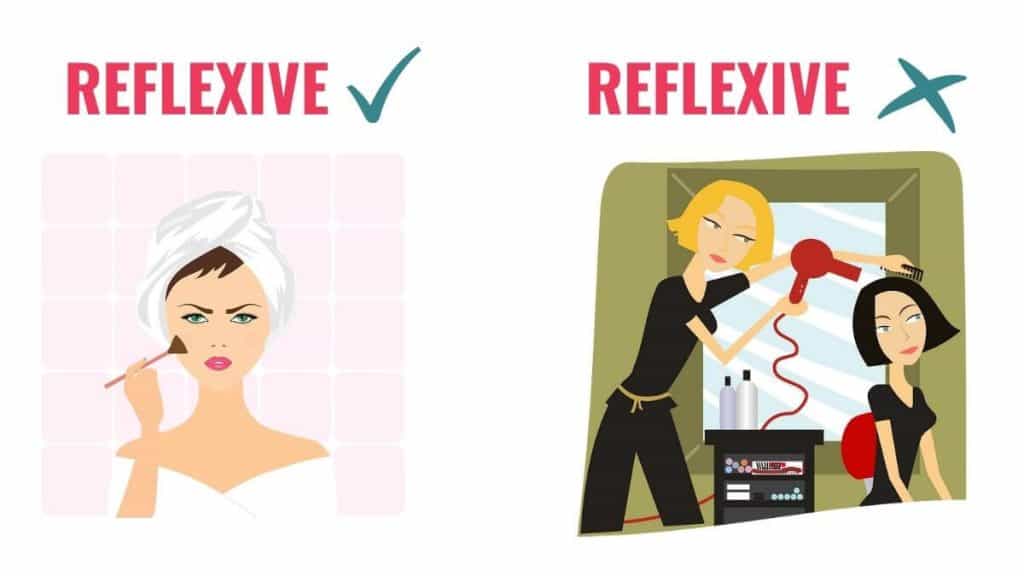If you’re learning Spanish, you may have realized how important reflexive verbs are. Since these verbs are quite common in any type of conversation, many new and experienced learners wonder when and how to use reflexive verbs in Spanish.
Reflexive verbs are used to talk about actions that either people do to themselves or are affected by them. As a result, they are used to talk about:
- Daily routines
- Personal care
- Change of status:
- Social / Relationships
- Physical condition
- Emotional states
- Thought / Knowledge
- Reciprocal actions
In Spanish, reflexive verbs are applied in a wider variety of contexts compared to in English. As a result, for many learners, knowing when and how to use these types of verbs can be very challenging. For that reason, in the following sections, we’ll talk about the most common contexts where you can use these verbs.
Additionally, we’ll provide phrase structures and real-life examples of how to use these verbs. Hopefully, by the end of this, you’ll have a better understanding of how and when to use reflexive verbs in Spanish.
Get a Step-by-Step Map to Learning Spanish
Join the Tell Me In Spanish community and get a copy of my step-by-step Spanish Learner’s Roadmaps and tricky synonyms & vocab cheat sheets.
When to Use Reflexive Verbs in Spanish
Reflexive verbs are quite common in any Spanish conversation. However, for many people it is difficult to know when you need to use these verbs. As a result, reflexive verbs may be one of the most difficult topics to learn.
As a general rule, reflexive verbs are used when describing an action that you perform and that is going to reflect on you. In other words, you will be affected or beneficiated by an action that you did.

Yo me cepillo el cabello todas las mañanas
I brush my hair every morning
Antes de comer, me lavo las manos
Before eating, I wash my hands
Yo me quito los zapatos para no ensuciar la alfombra
I take my shoes off so I don’t make the carpet dirty
Notice in these previous examples that it is just one person doing and receiving the action: me. It’s me who brushes my hair and it’s me who is going to be beneficiated by this action.
Now, let’s see the most common real-life contexts where you need to use reflexive verbs.
Uses of Reflexive Verbs in Spanish
Reflexive verbs are used when the person performing an action is the person receiving or being affected by that action. In other words, with reflexive verbs, the subject and the object are the same entity. In general, these actions are activities that you do on yourself.
In Spanish, these are some of the most common contexts where reflexive verbs are needed:
- Talking about personal care activities
- Describing your daily routines
- Talking about a change of status
- Talking about reciprocal actions
One thing to keep in mind is that in Spanish we have more verbs with reflexive form than in English. As a result, if you translate a sentence, you will notice that the English version not always will have a reflexive pronoun:
Yo me baño
I shower
Talking about personal care activities
One of the most common contexts where you can use reflexive verbs is to talk about different activities related to your personal care and hygiene. After all, a person does these activities on herself or himself. The only rules you need to follow are:
- Conjugating the reflexive verb (to any thence you need)
- Match the reflexive pronoun with the person performing the action
(Subject) + [reflexive pronoun] + [verb conjugated] + [complement]
(Yo) me baño después de correr
I shower after running
¿Ya te lavaste las manos?
Did you already wash your hands?
Mi novio se afeita cada tres días
My boyfriend shaves every three days
Nosotros nos cepillamos los dientes antes de dormir
We brush our teeth before going to bed
Take Note: Unlike English, in Spanish, we don’t always need to use the personal pronouns to indicate who is performing the action. We can know this by looking at the conjugation of the verb and the context. But when it comes to reflexive verbs, you always need to include the reflexive pronouns.
Related Resource: How to Conjugate Reflexive Verbs in Spanish
Using reflexive verbs to talk about daily routines
As you may imagine, there are a lot of daily routines that people perform on themselves. Therefore, this is one of the most popular contexts where reflexive verbs are needed. Here are some examples of how to use reflexive verbs in this context:
(Subject) + [reflexive pronoun] + [verb conjugated]
Todos los días, me levanto muy temprano
Every day, I wake up very early
Nosotros nos subimos al autobús a las 8
We get on the bus at 8
Joel se peina y se pone la corbata antes de ir a desayunar
Joel combs his hair and puts on his tie before having breakfast
Example: morning routine using reflexive verbs in Spanish
| Spanish | English |
| Todos los días me despierto a las siete, pero espero unos minutos para levantarme. Después, me baño y me pongo la ropa que dejé preparada desde ayer. Antes de desayunar, me maquillo y me peino.Desayuno a las 8, lavo los trastes y, después, me cepillo los dientes, preparo mis cosas, me pongo los zapatos y me voy a trabajar. | Every day I wake up at seven, but I wait a few minutes to get up. Afterward, I shower and put on the clothes I prepared yesterday. Before having breakfast, I put makeup on and comb my hair. I have breakfast at 8, I wash the dishes. Then, I brush my teeth, prepare my things, put my shoes on and I go to work. |
Take Note: When talking about daily routines, many Spanish learners get confused because there are some verbs that you can use for this context that are not reflexive (comer – to eat, lavar – to wash, etc). Mixing reflexive and non-reflexive verbs is quite common in Spanish. For that reason, it’s important that you know when to use each type of verb.
Related Resource: Difference Between Reflexive and Non-Reflexive Verbs in Spanish
Change of Status
In Spanish, reflexive verbs can also be used to express a change of status. As you can imagine, ‘change of status’ is quite broad, but the most common situations that fit in this category are:
- Physical condition
Martín se lastimó la rodilla
Martin hurt his knee
No voy a correr porque me canso muy rápido
I’m not going to run because I get tired pretty fast
- Relationships
Patricia se enamoró de Juan Carlos
Patricia fell in love with Juan Carlos
Mi tía se casó cuando tenía 24 años
My aunt got married when she was 24 years old
- Social status
Mi vecina se gradúa la próxima semana
My neighbor graduates next week
Jonathan ganó la lotería y se volvió rico
Jonathan won the lottery and he became rich
- Emotional states
Mi tia se preocupa mucho por mis primos
My aunt worries too much for my cousins
¿Por qué te enojaste conmigo? Yo no te hice nada
Why did you get mad with me? I didn’t do anything to you
- Knowledge / Thought
Sara se enteró de que ganó la lotería
Sara found out that she won the lottery
Nos dimos cuenta que cometimos un error
We realize that we made a mistake
Take Note: When talking about change of status, it’s important that you choose a verb that reflects what you want to express. As a clue, most English verbs that have ‘ to get…’ are going to be reflexive verbs.
Related Resource: Most Common Reflexive Verbs in Spanish
Talking About Reciprocal Actions
Another common use of reflexive verbs is to talk about reciprocal actions. These types of actions follow the same rule that reflexive verbs: reciprocal actions are actions performed at the same time by more than one person. These actions are done on each other.
Daniel y Carolina se casaron ayer
Daniel and Carolina got married yesterday
Ustedes se besaron en el parque
You guys kiss on the park
Tus papás se aman mucho
Your parents love each other so much
Jaime y yo nos abrazamos y nos despedimos
Jaime and I hug and say goodbye to each other
Take Note: As its name says, reciprocal actions express that an action is being performed and received equally for two or more people. Therefore, you always need to use reflexive verbs in their plural form.
Related Resource: Difference Between Reciprocal and Reflexive Verbs in Spanish
Wrapping Up
Learning how and when to use reflexive verbs in Spanish can be a challenging topic for new and experienced Spanish learners. For that reason, in this article, we discussed the most common context and situations where these verbs are needed.
We learned that reflexive verbs are used when people are performing an action on themselves. In other words, the person doing the action will also be the person affected by that action.

Real-life situations where we apply this concept are:
- Talking about personal care activities
- Describing daily routines
- Talking about changes of status
- Talking about reciprocal actions
Hopefully, now you have a better understanding of when to use reflexive verbs in Spanish.



